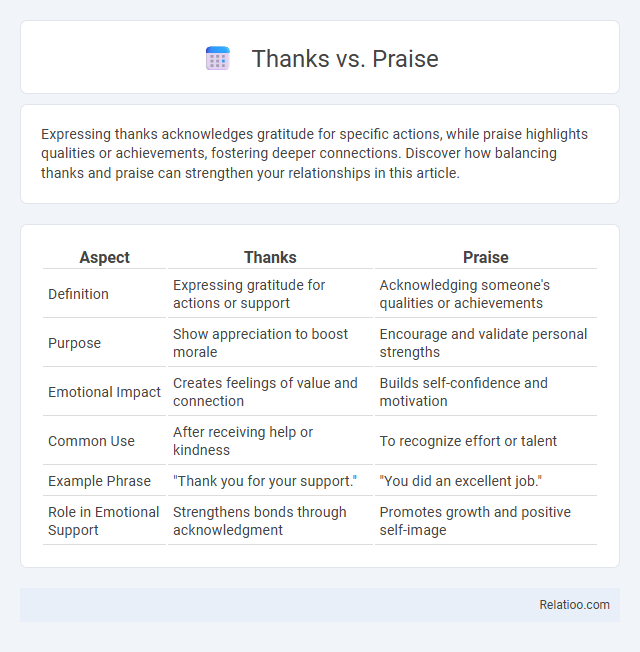Expressing thanks acknowledges gratitude for specific actions, while praise highlights qualities or achievements, fostering deeper connections. Discover how balancing thanks and praise can strengthen your relationships in this article.
Table of Comparison
| Aspect | Thanks | Praise |
|---|---|---|
| Definition | Expressing gratitude for actions or support | Acknowledging someone's qualities or achievements |
| Purpose | Show appreciation to boost morale | Encourage and validate personal strengths |
| Emotional Impact | Creates feelings of value and connection | Builds self-confidence and motivation |
| Common Use | After receiving help or kindness | To recognize effort or talent |
| Example Phrase | "Thank you for your support." | "You did an excellent job." |
| Role in Emotional Support | Strengthens bonds through acknowledgment | Promotes growth and positive self-image |
Understanding the Difference: Thanks vs Praise
Thanks expresses gratitude for a specific action or favor, while praise highlights admiration for someone's qualities or achievements. Understanding the difference between thanks and praise helps you communicate appreciation more effectively by choosing the appropriate term based on context. Your ability to distinguish between these ensures clearer recognition of actions versus personal attributes.
Definitions: What is Thanks? What is Praise?
Thanks is an expression of gratitude or acknowledgment for a favor, help, or kindness received, often conveyed through words like "thank you." Praise refers to the expression of approval, admiration, or commendation directed toward someone's qualities, actions, or achievements. While thanks focuses on appreciation for benefits received, praise emphasizes recognizing and valuing positive attributes or accomplishments.
Psychological Impact of Thanks and Praise
Thanks and praise both positively influence psychological well-being, but their impacts differ significantly. Expressions of thanks foster feelings of gratitude and social connection, enhancing your overall emotional resilience and mental health. Praise, when specific and genuine, boosts self-esteem and motivation by reinforcing valued behaviors, leading to increased confidence and personal growth.
When to Use Thanks
Thanks is best used for expressing gratitude in casual or informal situations, such as thanking a colleague or friend quickly. Praise involves highlighting someone's achievements or qualities, making it more about admiration than just gratitude. You should use thanks when you want to acknowledge kindness, help, or support directly and briefly.
When to Use Praise
Praise is best used when explicitly acknowledging someone's specific achievements, qualities, or efforts, making it ideal for formal recognition or performance feedback. Thanks typically conveys gratitude for help, favors, or kindness, often in more casual or general contexts. Use praise to motivate and reinforce positive behavior by highlighting exceptional contributions or skills.
Cultural Nuances: Thanks vs Praise
Thanks expresses gratitude for a specific act or favor, often used in casual or formal settings to acknowledge help or kindness directly received. Praise conveys admiration or approval for someone's qualities or achievements, frequently tied to cultural contexts where public recognition boosts social status and motivation. Understanding these nuances helps you communicate more effectively by choosing thanks to show appreciation for immediate actions and praise to honor ongoing traits or accomplishments.
Benefits of Expressing Thanks
Expressing thanks fosters positive relationships, boosts emotional well-being, and encourages a culture of appreciation. Your genuine gratitude can strengthen social bonds, enhance cooperation, and increase overall happiness. Thanks carries a personal touch, making the recipient feel valued and motivated.
Benefits of Giving Praise
Giving praise enhances motivation by recognizing specific achievements, fostering a positive environment that encourages continued effort and improvement. Unlike a simple thank you, praise explicitly acknowledges the value of actions, boosting self-esteem and reinforcing desired behaviors. This targeted recognition builds stronger relationships and promotes a culture of appreciation in both personal and professional settings.
Common Mistakes: Mixing Thanks and Praise
Mixing thanks and praise often leads to unclear communication because thanks express gratitude for a specific act, while praise highlights qualities or achievements. You may unintentionally dilute your message by saying "Thanks for being amazing," which blends appreciation with admiration, causing confusion. Clearly distinguishing thanks from praise ensures your acknowledgment appropriately matches the context and intention.
Practical Tips for Balancing Thanks and Praise
Balancing thanks and praise effectively enhances your communication by recognizing both effort and results. Offer specific thanks to acknowledge genuine contributions, while using targeted praise to motivate and reinforce positive behavior in your team or relationships. Your ability to distinguish when to thank versus when to praise fosters trust and encourages ongoing engagement.

Infographic: Thanks vs Praise
 relatioo.com
relatioo.com